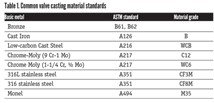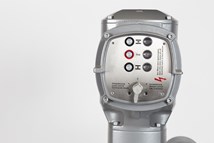The Eccentric Plug Valve
The first non-lubricated eccentric plug valve was developed in the late 1920s, designed to solve the issue of pitch buildup in paper mill valves.
#basics #water-wastewater #knowyourvalves
The first non-lubricated eccentric plug valve was developed in the late 1920s, designed to solve the issue of pitch buildup in paper mill valves. Due to the eccentric nature of the valve, closure was still attainable even in the harsh conditions of a paper plant where pitch and tar would clog and bind other valve designs. As elastomers have advanced over the years, the eccentric plug valve has gained favor throughout many industries and applications. The valve is known for its reliability and versatility across many different applications. The eccentric plug valve can be found in municipal wastewater and water systems, industrial processes handling slurries or chemicals, and demanding environments such as power generation and mining operations where durability and performance are critical. The valve is well known for on/off operation, throttling, and as a very capable control valve.

Eccentric plug valves are available in a wide range of sizes. They have been a top choice across many industries for nearly a century. Source: DeZURIK
How eccentric plug valves work
A rectangular shaped body seat and plug in the shape of a quarter-cylinder are employed in the most common eccentric plug valve configuration. What makes an eccentric plug valve “eccentric” is that the body seat axis is not the same as the plug face axis. The offset of the two axes of rotation causes the plug to cam into the seating position (see Figure 2). This means that throughout operation, there is no rubbing or scraping of the plug into the body seat, significantly reducing wear of the critical seating surfaces and significantly prolonging the valve’s lifespan. During closing the eccentric action presses the plug face into the body seat with a smooth, low torque, cam-like action creating a positive seal with minimal seating compression. During opening, the plug cams out of the body seat without scraping. This is ideal for handling clean and dirty liquids, sludge, slurries and gases. This design also enables precise flow control, making eccentric plug valves a great option for control valve applications.

Figure 2: The axis of rotation is offset between the plug and the body seat creating a cam-like opening and closing operation. Source: DeZURIK
Design features of eccentric plug valves
Eccentric plug valves are engineered with several innovative features that enhance their performance, reliability and adaptability across a wide range of applications. Available in a broad size range, from small 1/2-inch valves to jumbo 72-inch valves and beyond, these valves are designed to meet the demands of diverse systems and flow requirements. Design features of eccentric plug valves include:
• Off-center rotation: The plug rotates around an axis that is offset from the seat, reducing friction and minimizing wear.
• Cam-action sealing: The eccentric motion presses the plug face into the seat during closure without scraping or sticking.
• Offset plug profile: Eccentric plug valve plugs have an offset profile (see Figure 3) which means the plug is completely out of the flow path when the valve is open. This enables increased flow efficiency while allowing relatively large solids and stringy materials to pass through without clogging.
• Resilient or metal plug facings: Offers flexibility for various applications, with many choices for resilient plug facings providing drip-tight shutoff and metal plugs achieving ANSI/FCI 70-2 Class IV performance.
• Wide range of body materials: Valves are available in cast iron, ductile iron and stainless steel for typical applications. When situations necessitate, special materials like bronze, aluminum and Monel are available.
• Welded seat overlay: The raised, welded-in body seat, normally of nickel, is designed to provide the longest seat life.
• Internal linings: For special environments, valve interiors can be coated with materials including soft rubber lining, glass or Nedox.

Figure 3: The eccentric plug has an offset profile which provides a full sealing surface but no obstruction to flow when the valve is in the open position. Source: DeZURIK
The design features of the eccentric plug valves are governed by certain industry standards. The standards that should be considered when selecting a valve differ by industry. For the eccentric plug valve in North America, some relevant codes and standards organizations include the American Water Works Association (AWWA), the American Society of Mechanical Engineers (ASME), the Manufacturers Standardization Society (MSS) and the American Petroleum Institute (API). These standards should be considered during the design phase of any project. Some prominent standards that may be of use include:
- AWWA C517: Resilient-Seated Cast-Iron Eccentric Plug Valves
- ASME – B16.1: Gray Iron Pipe Flanges and Flanged Fittings: Classes 25, 125, and 250
- ASME – B16.34: Valves — Flanged, Threaded, and Welding Ends
- ASME – B16.5: Pipe Flanges and Flanged Fittings: NPS 1/2 through NPS 24, Metric/Inch Standard
- MSS SP 25: Standard Marking Systems for Valves, Fittings, Flanges, and Unions
- MSS SP 61: Pressure Testing of Valves
- MSS SP 78: Gray Iron Plug Valves, Flanged and Threaded Ends
- MSS SP 108: Resilient-Seated Cast Iron Eccentric Plug Valves
- API 6D: Specification for Pipeline and Piping Valves
- API 599: Metal Plug Valves — Flanged, Threaded, and Welding Ends
Applications of eccentric plug valves
Eccentric plug valves are a preferred choice for many different applications across industries and applications:
- Municipal water and wastewater: Eccentric plug valves are extensively used in pump stations, wastewater treatment plants, lift stations and collections systems and in water treatment plants and distribution networks. Their ability to handle corrosive sewage containing large solids, grit, stringy materials and sludge ensures long-lasting performance. Their efficient design and superior flow characteristics are ideally suited for critical raw and finished water applications.
- Industrial processes: These valves work well handling abrasive slurries, viscous chemicals and other challenging fluids. Materials of construction can be selected for tight shutoff or minimal wear, and the valves find applications in many industries such as chemical processing, pulp and paper and food and beverage production.
- Power generation and mining: In environments such as power plants and mining operations, eccentric plug valves deliver high performance under demanding pressures and abrasive conditions. Their durability makes them a reliable choice for applications involving slurries, ash handling and other harsh media.
- As control valves: Rectangular ported eccentric plug valves are highly effective control valves, particularly in water and wastewater applications. With their high cavitation resistance and favorable characteristics, they excel in maintaining stable flow control. Available in a wide size range, the eccentric plug valve can be sized properly to precisely control the flow without excessive wear. The rectangular ported eccentric plug valve provides a solution from 1/2-in. through 72-in. NPS with the potential to go even larger (see Case Study).
Installation considerations for the eccentric plug valve
Eccentric plug valves are rugged and, in many applications, will last for decades. To ensure the longest service life possible, certain considerations should be taken during the design phase pertaining to installation orientation. The main factor to consider is what type of media will flow through the valve. Media types can be broken into two main categories:
- Dirty liquids and dirty gases containing suspended solids.
- Clean liquids and clean gases containing no suspended solids.
- In applications where the media contains suspended solids, it is preferred that the solids settle outside of the valve when the flow stops. In horizontal installations, the higher pressure should be against the closed face of the plug to ensure most solids settle outside of the valve body. In vertical installations, the plug face should be installed such that it closes upward regardless of flow direction, to prevent solids from settling down into the valve body (see Figure 4).
- In applications with no suspended solids, the valve should be installed in the flow-to-close orientation so that the higher pressure pushes against the backside of the plug when it is in the closed position (see Figure 5). This is the same whether the valve is installed in a horizontal or vertical run of pipe.


TOP: When pipeline media contains suspended solids, consideration should be given to what happens to the solids when they settle out of the fluid. Source: DeZURIK
BOTTOM: In clean water and gas applications, the valve should be installed in the flow-to-close orientation. Source: DeZURIK
Maintenance
Maintenance for eccentric plug valves is generally simple. Often, the packing gland can be tightened to stop leaks that may occur around the valve stem. If the packing ever needs to be replaced, it can be easily done in the field by maintenance personnel. If the valve does not fully seal when in the closed position, the actuator stops can be adjusted to advance the plug further into the seat. If the plug should ever need to be replaced, the bonnet/cover can be removed while the valve body remains installed in the pipeline.
Conclusion
The eccentric plug valve stands out as a reliable and versatile solution for a broad range of applications. With a wide selection of materials and internal linings to choose from, eccentric plug valves are suitable for many industries including industrial processes, mining and municipal water systems, to name a few. With its proven ability to handle abrasive media, slurries, highly viscous substances like sludge or pitch, and to excel in clean fluid applications, the eccentric plug valve has become a trusted choice across industries. Its longevity, paired with its ease of maintenance, make it a favorite among plant operators and maintenance personnel.
As the demands of modern systems push the limits of size and capacity, the eccentric plug valve continues to demonstrate its ability to meet those challenges, providing operators with a long-lasting and cost-effective solution for their flow control needs.
RELATED CONTENT
-
Check Valve Installation Considerations to Maximize Process Performance
Key considerations in successful check valve performance.
-
Knifegate Valve Maintenance and Repair
Knife gate valves are used to provide isolation in various applications including oil sands slurries, pulp stock, waste water and power generation.
-
America Moves Toward a Stronger Infrastructure
Here’s what you need to now about the multi-billion-dollar funding designated for the water and wastewater markets as part of the American Jobs Plan.











 Unloading large gate valve.jpg;maxWidth=214)